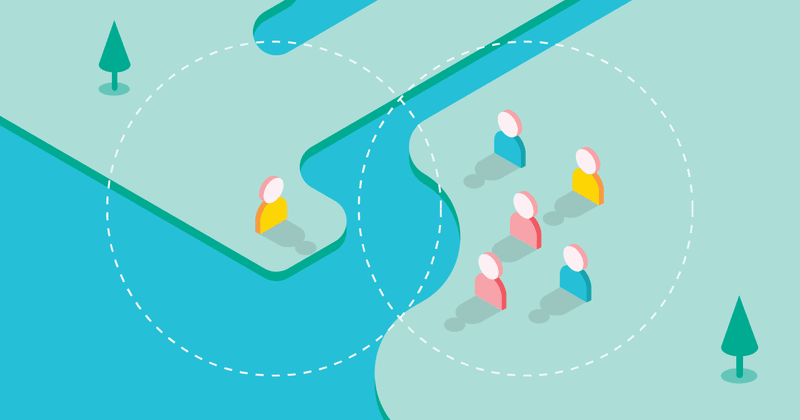The Blurring Line Between Business and Personal SaaS
And how developers can benefit from it

Is Zoom B2B or B2C? It may be powering remote work for Fortune 100 companies, but it also took Grandma’s knitting club online during the Covid-19 pandemic. As more and more work gets done on smartphones and tablets, apps are straddling the shrinking gap between traditional B2B SaaS and consumer-oriented “Personal SaaS”. And that’s a huge opportunity for both developers and the app stores.
The Changing Mobile Landscape
As more and more consumers turn to mobile-first apps to solve their everyday problems, there’s a growing middle ground between personal SaaS and business SaaS. If you think about it, we’ve steadily been moving our work lives onto mobile for the last 10+ years. I check my work email, use messaging apps, and take Zoom meetings on my iPhone or iPad almost daily, and you probably do too. And if you’re like me, you use many of those apps for a combination of personal and work-related tasks.
Now more than ever before, there’s a gradient of use cases between individual consumers and enterprise businesses. People all over the world are doing more work on their mobile devices, in part because mobile is more suited to getting certain things done—like using your phone camera to scan and save documents.
Take the photo editing app Photoroom, for example. Photoroom sounds like a personal SaaS app: it lets you quickly replace the background of photos with backdrops and graphics that simulate professionally-shot images. While this sounds like it would be great for the casual Instagram user, it turns out the people who are getting the most value out of Photoroom are people who operate e-commerce stores on Etsy and Shopify. They use the app to create professional-looking product photos and ads for their businesses. So is Photoroom a personal SaaS or business SaaS app?
People like Shopify store owners fall into this growing middle ground of people who use apps for their business, but think and operate more like individual consumers. There’s a huge opportunity for business SaaS companies to take a consumer-minded approach to selling their apps and diversify their pricing structure with plans that fit consumer and small business use cases.
Pricing Your SaaS App
You don’t have to box yourself into a single pricing model—and you shouldn’t. If you structure your app business to meet the needs of individual users, enterprise clients, and everyone in between, you’ll get the best of both worlds and then some.
Zapier is a perfect example of this kind of diverse pricing structure. It has a free tier for people just getting their feet wet with the value of automation. And their paid plans range from a consumer- and small-business friendly $20/month to thousands of dollars a month for large companies that need advanced features and more tasks.
There are a couple of major benefits to marketing your app to consumers rather than directly to businesses. First, mobile is a great way to acquire and onboard new users who have the consumer mindset (even if they happen to work for a large company). This actually happened to me recently. I discovered Otter.ai and started experimenting with it to record and transcribe notes while I walk. Later, I found out I could plug it into Zoom and get automatic transcription for all my business meetings.
Often, individuals who work at big companies will try out a new app on their own (as a personal expense), then push it up the stack if they like it. Zapier is famous for getting individuals to sign up to make their work easier, then eventually getting the whole company on board.
Plus, if you sell to a small business or sole proprietorship, there’s a good chance that they’ll grow with you and eventually move into a higher price tier as they become more successful and have increased cashflow.
Another benefit of this approach is that you can start by releasing a consumer offering, then add a B2B version later. Jacob and I recently discussed this with our friend Nico Wittenborn on the Sub Club podcast. As an app investor, Nico has seen several apps employ this strategy—launching a personal SaaS product, then eventually releasing a business offering and winning enterprise contracts.
Also Read: Optimize App Revenue Using Statsig and RevenueCat
What Apple and Google Can Do
Even though more work is getting done on mobile, the app stores are still oriented around the consumer, casual, lifestyle use case—which doesn’t really map to business purchases. The app stores even famously exempt business SaaS apps like Slack from having to include in-app purchases. But that’s to the detriment of everyone involved. The companies lose the opportunity to acquire users via their app and have them pay through the app. People who download those apps have to sign up and pay on the web, which is often a poor experience compared to what could’ve been built into the app natively. And Apple is missing out on a huge revenue opportunity.
“But Slack isn’t going to pay Apple and Google 30% right off the top!” I hear you shouting at your iPhone screen. Of course not! And they shouldn’t. This is one of the many areas where Apple and Google need to rethink their app stores for 2021—instead of clinging to ideas from 2008 about how the App Store should be run.
Here are just a few things Apple and Google could do right now:
- Enable business accounts for in-app purchases
- Allow user- and usage-based pricing tiers
- Offer a discounted commission (say 5%, which is competitive with web payment providers like Stripe) to developers for purchases made via these business accounts
If you squint, Apple’s Family Sharing and Ask to Buy features resemble what could work for setting up business accounts and authorizing individuals to purchase from them.
For a mobile-first company trying to serve business use cases, there’s currently way too much friction and untapped potential. I should know—I regularly hear about this from frustrated RevenueCat customers who want the simplicity of in-app purchases for themselves and their customers, but can’t fit their offerings into the consumer-oriented app stores.
Conclusion
I think this blurry line between personal and business SaaS is a massive opportunity for mobile app monetization, and I’m excited to see what the next few years look like. Developers who can build products that span the personal/business SaaS gradient have the potential to tap much larger markets and offer pricing that better aligns with the ever-increasing value apps deliver to individuals and businesses alike.
You might also like
- Blog post
The complete guide to SKAdNetwork for subscription apps
Understanding Apple's privacy-first attribution
- Blog post
“A big market is great only if you can take a substantial share of it” — Patrick Falzon, The App Shop
On the podcast: estimating the revenue potential of an app, crafting an exit strategy, and why LTV is such a terrible metric.
- Blog post
Effective testing strategies for low-traffic apps
Is A/B testing off the table? Let’s rethink experimentation.

